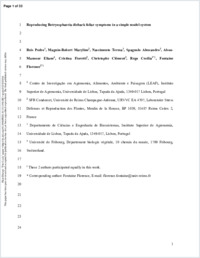Reproducing Botryosphaeria dieback foliar symptoms in a simple model system
- Reis, Pedro Centro de Investigaçao em Agronomia, Alimentos, Ambiente e Paisagem, Instituto Superior de Agronomia, Universidade de Lisboa, Lisbon, Portugal.
- Magnin-Robert, Maryline SFR Condorcet, Université de Reims Champagne-Ardenne, URVVC EA 4707, Laboratoire Stress, Défenses et Reproduction des Plantes, Reims, France.
- Nascimento, Teresa Departamento de Ciências e Engenharia de Biossistemas, Instituto Superior de Agronomia, Universidade de Lisboa, Lisbon, Portugal.
- Spagnolo, Alessandro SFR Condorcet, Université de Reims Champagne-Ardenne, URVVC EA 4707, Laboratoire Stress, Défenses et Reproduction des Plantes, Reims, France.
- Abou-Mansour, Eliane Université de Fribourg, Département biologie végétale, Fribourg, Switzerland.
- Fioretti, Cristina SFR Condorcet, Université de Reims Champagne-Ardenne, URVVC EA 4707, Laboratoire Stress, Défenses et Reproduction des Plantes, Reims, France.
- Clément, Christophe SFR Condorcet, Université de Reims Champagne-Ardenne, URVVC EA 4707, Laboratoire Stress, Défenses et Reproduction des Plantes, Reims, France.
- Rego, Cecilia Centro de Investigaçao em Agronomia, Alimentos, Ambiente e Paisagem, Instituto Superior de Agronomia, Universidade de Lisboa, Lisbon, Portugal.
- Fontaine, Florence SFR Condorcet, Université de Reims Champagne-Ardenne, URVVC EA 4707, Laboratoire Stress, Défenses et Reproduction des Plantes, Reims, France.
-
2016
English
Botryosphaeria dieback is a grapevine trunk disease with a worldwide distribution and associated with Diplodia seriata and Neofusicoccum parvum among several other Botryosphaeriaceae species. The aforementioned xylem-inhabiting fungi cause wood lesions, leaf and berry symptoms and eventually lead to the death of the plant. The aim of this work was to develop a simple model system to reproduce the foliar symptoms caused by D. seriata and N. parvum to better characterize fungal pathogenicity and determine the mechanisms involved in symptom development. Green stems of grafted grapevine cuttings cv. Aragonez were inoculated with three isolates of N. parvum and two isolates of D. seriata with different degrees of virulence and the experiment was repeated four times from 2011 to 2014. Three months after inoculation, the lesions associated with N. parvum were larger than those associated with D. seriata. Similarly, eight months after inoculation the percentage of plants showing foliar symptoms was greater in the N. parvum treatments than in the D. seriata treatments. During the emergence of foliar symptoms, plant stress-related responses were modulated in green stems and leaves, especially a down-regulation of superoxide dismutase (SOD) and fasciclin-like arabinogalactan protein (fascAGP) and an up-regulation of stilbene synthase (STS) with an accumulation of phenolics. In conclusion, the simple model system developed allowed a good characterization of isolate pathogenicity and correlation with foliar symptoms of Botryosphaeria dieback, namely spots on leaf margin and blade.
- Faculty
- Faculté des sciences et de médecine
- Department
- Département de Biologie
- Language
-
- English
- Classification
- Biological sciences
- License
-
License undefined
- Identifiers
-
- RERO DOC 259285
- Persistent URL
- https://folia.unifr.ch/unifr/documents/304943
Statistics
Document views: 109
File downloads:
- Fichier principal: 277
